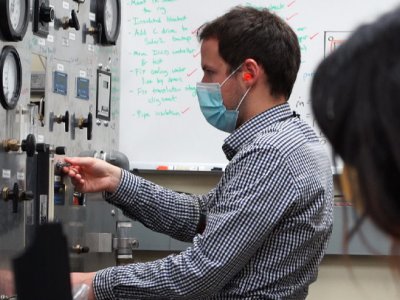Every week, I haul a container of my accumulated household trash to the curb (which, fortunately for my back, is on wheels), where it is taken away and put in the ground in an engineered landfill. We know that we throw out a lot of garbage, typically 3–5 pounds per day or 30 pounds a week per person in the United States. We are reminded of all that trash by the nearly endless lines of large garbage bins sitting out on the curb one day every week. But what about the other things we don’t see that we are throwing out, like those invisible gases emitted by our automobiles?
If you’re like most car-owning Americans, you drive one of the 250 million vehicles with internal combustion engines that emit carbon dioxide (CO2), a long-lived greenhouse gas that is the main contributor to climate change. If you collected your car’s CO2 emissions like you do your garbage each week, how many pounds of CO2 would you have to haul out to the curb? The answer is a lot more than 30 pounds.

A gallon of gasoline weighs about 6 pounds. After you burn it, you might think it must be lighter because it just goes into the atmosphere, right? Not quite. Sure, the liquid becomes a gas, and so its lower density means it floats away. But what you release weighs a lot more: nearly 20 pounds of CO2 from each gallon.
The reason for this increase in weight is because when you burn gasoline, it goes from a mixture of carbon and hydrogen molecules (hydrocarbons) to carbon and oxygen (or CO2) and water (H2O). When you replace those light hydrogen molecules from the hydrocarbon and swap them with the much bigger and heavier oxygen molecules, the gas that is produced weighs a lot more than the original fuel.
If you use the daily average of gasoline use in the U.S., which is 1.25 gallons, you would have to haul 25 pounds of “trash” CO2 to the curb each day.
But wait! There is more! The oil to make that gasoline had to be pulled out of the ground, which could have released the potent greenhouse gas methane during its extraction. Then there is transport, refining, and more transport, all before that gasoline gets to your filling station, which also results in CO2 and other greenhouse gas emissions along the way. All that could add 15–40% more CO2 equivalent emissions to the total, depending on specific locations and operations. Assuming the minimum 15% increase, we need to haul another 4 pounds for your daily gasoline use.
Therefore, if we had to take all the greenhouse gas emissions accumulated along the way, it would be 29 pounds a day, or 200 pounds per week, which is the weight of an average 20-year-old U.S. male. That is a lot of “trash” that goes up into the atmosphere just from your own gasoline use.
Another way to look at the amount of 29 pounds per day is to consider the CO2 emissions from that amount of gasoline versus your own human fuel or the food you eat. Consuming 2,000 Calories a day releases about 2 pounds a day of CO2 from the food into the environment. Food also has CO2 emissions before it reaches your table, which is about 22–25 pounds per day in the U.S. So, the bottom line: using 1.25 gallons of gasoline in your car every day produces as much CO2, or maybe a little more, than all the CO2 emissions needed to feed you.

Next time you buy a car, consider avoiding the 200 pounds a week of CO2 trash. Get an electric vehicle and use some solar panels or green electricity to charge it. The world cannot afford to engineer a CO2 trash collection system.
Bruce Logan is the director of the Institute of Energy and the Environment and an Evan Pugh University Professor and Kappe Professor of Environmental Engineering. His research focuses on developing new renewable energy technologies, such as microbial fuel cells and thermal batteries, for achieving an energy-sustainable water infrastructure, wastewater treatment, and bioremediation.





